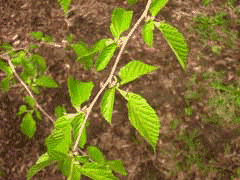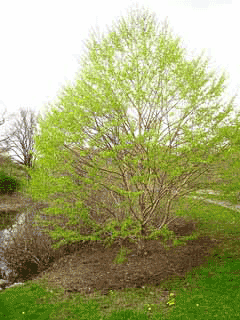 |
|
http://commons.wikimedia.org/wiki/User:Dalgial |
 |
| http://commons.wikimedia.org/wiki/User:KENPEI |
Translate this page:
Summary
Filbert is similar to the common Hazel with a nut more fully enclosed by the husk. It too is ideal for coppicing. The nuts are ready to harvest in autumn when the husks have yellowed.
Filbert is a Carbon Farming Solution plant with similar properties to hazelnut.
Physical Characteristics

 Corylus heterophylla is a deciduous Tree growing to 7 m (23ft).
Corylus heterophylla is a deciduous Tree growing to 7 m (23ft).
See above for USDA hardiness. It is hardy to UK zone 5. It is in flower from April to May, and the seeds ripen from September to October. The species is monoecious (individual flowers are either male or female, but both sexes can be found on the same plant) and is pollinated by Wind. The plant is self-fertile.
Suitable for: light (sandy), medium (loamy) and heavy (clay) soils. Suitable pH: mildly acid, neutral and basic (mildly alkaline) soils and can grow in very alkaline soils.
It can grow in semi-shade (light woodland) or no shade. It prefers moist soil. The plant can tolerates strong winds but not maritime exposure.
UK Hardiness Map
US Hardiness Map
Synonyms
Plant Habitats
Woodland Garden Secondary; Sunny Edge; Dappled Shade; Shady Edge;
Edible Uses
Edible Parts: Oil Seed
Edible Uses: Oil
Seed - raw or cooked[46, 61, 105, 177]. The seed, which has a hard shell, is of relatively good flavour[183]. Rich in oil. The seed ripens in mid to late autumn and will probably need to be protected from squirrels[K]. When kept in a cool place, and not shelled, the seed should store for at least 12 months[K]. An edible oil is obtained from the seed.
References More on Edible Uses
Medicinal Uses
Plants For A Future can not take any responsibility for any adverse effects from the use of plants. Always seek advice from a professional before using a plant medicinally.
Appetizer Digestive
The seed is digestive and appetizer[218].
References More on Medicinal Uses
The Bookshop: Edible Plant Books
Our Latest books on Perennial Plants For Food Forests and Permaculture Gardens in paperback or digital formats.

Edible Tropical Plants
Food Forest Plants for Hotter Conditions: 250+ Plants For Tropical Food Forests & Permaculture Gardens.
More

Edible Temperate Plants
Plants for Your Food Forest: 500 Plants for Temperate Food Forests & Permaculture Gardens.
More

More Books
PFAF have eight books available in paperback and digital formats. Browse the shop for more information.
Shop Now
Other Uses
References More on Other Uses
Cultivation details
Management: Coppice Management: Standard Other Systems: Strip intercrop Regional Crop Staple Crop: Protein-oil
An easily grown plant, it succeeds in most soils, but is in general more productive of seeds when grown on soils of moderate fertility[11, 200]. It does less well in rich heavy soils or poor ones[11, 63]. Does well in a loamy soil[11]. Very suitable for an alkaline soil[11], but it dislikes very acid soils[17]. Plants are fairly wind tolerant[1, 11]. This species is cultivated in Asia for its edible seed[61] but it is of little value as a nut bearer in Britain[1]. Closely related to C. avellana[1]. Members of this genus bear transplanting well and can be easily moved even when relatively large[11].
Carbon Farming
-
Management: Coppice
Cut to the ground repeatedly - resprouting vigorously. Non-destructive management systems maintaining the soil organic carbon.
-
Management: Standard
Plants grow to their standard height. Harvest fruit, seeds, or other products. Non-Destructive management systems.
-
Other Systems: Strip intercrop
Tree crops grown in rows with alternating annual crops.
-
Regional Crop
These crops have been domesticated and cultivated regionally but have not been adopted elsewhere and are typically not traded globally, Examples in this broad category include perennial cottons and many nuts and staple fruits.
-
Staple Crop: Protein-oil
(16+ percent protein, 16+ percent oil). Annuals include soybeans, peanuts, sunflower seeds. Perennials include seeds, beans, nuts, and fruits such as almond, Brazil nut, pistachio, walnut, hazel, and safou.
References Carbon Farming Information and Carbon Sequestration Information
Temperature Converter
Type a value in the Celsius field to convert the value to Fahrenheit:
Fahrenheit:
The PFAF Bookshop
Plants For A Future have a number of books available in paperback and digital form. Book titles include Edible Plants, Edible Perennials, Edible Trees,Edible Shrubs, Woodland Gardening, and Temperate Food Forest Plants. Our new book is Food Forest Plants For Hotter Conditions (Tropical and Sub-Tropical).
Shop Now
Plant Propagation
Seed - best sown as soon as it is harvested in autumn in a cold frame[164]. Germinates in late winter or spring. Stored seed should be pre-soaked in warm water for 48 hours and then given 2 weeks warm followed by 3 - 4 months cold stratification[164]. Germinates in 1 - 6 months at 20°c[164]. When large enough to handle, prick the seedlings out into individual pots and grow them on in a cold frame or sheltered place outdoors for their first winter. Plant them out into their permanent positions in late spring or early summer[K]. Layering in autumn. Easy, it takes about 6 months[78, 200]. Division of suckers in early spring. Very easy, they can be planted out straight into their permanent positions.
Other Names
If available other names are mentioned here
Native Range
TEMPERATE ASIA: Russian Federation (Chita), Mongolia (east), Russian Federation (Habarovskij kraj, Primorye, Amur), China (Anhui Sheng, Gansu Sheng (east & south), Guizhou Sheng, Hebei Sheng, Heilongjiang Sheng, Henan Sheng, Hubei Sheng, Hunan Sheng, Jiangsu Sheng, Jiangxi Sheng, Jilin Sheng, Liaoning Sheng, Nei Mongol Zizhiqu (east), Ningxia Huizi Zizhiqu, Shaanxi Sheng, Shandong Sheng, Shanxi Sheng, Sichuan Sheng (northeast), Zhejiang Sheng), Korea, Japan (Hokkaidô, Honshu, Kyushu)
Weed Potential
Right plant wrong place. We are currently updating this section.
Please note that a plant may be invasive in one area but may not in your area so it's worth checking.
Conservation Status
IUCN Red List of Threatened Plants Status :

| Related Plants
|
| Latin Name | Common Name | Habit | Height | Hardiness | Growth | Soil | Shade | Moisture | Edible | Medicinal | Other |
| Corylus americana | American Hazel | Tree | 3.0 |
4-8
| | LMH | SN | M | 3 | 1 | 2 |
| Corylus avellana | Common Hazel, Common filbert, European Filbert, Harry Lauder's Walking Stick, Corkscrew Hazel, Hazel | Tree | 6.0 |
4-8
| M | LMH | SN | M | 5 | 2 | 5 |
| Corylus avellana pontica | | Tree | 0.0 |
-
| | LMH | SN | M | 4 | 0 | 3 |
| Corylus chinensis | Chinese Hazel | Tree | 24.0 |
5-9
| | LMH | SN | M | 2 | 0 | |
| Corylus colurna | Turkish Hazel, Chinese hazelnut, Turkish Filbert, Turkish Hazel | Tree | 20.0 |
4-7
| M | LMH | SN | M | 3 | 1 | 3 |
| Corylus cornuta | Beaked Hazel, California hazelnut, Turkish Filbert, Turkish Hazel | Shrub | 3.0 |
4-7
| M | LMH | SN | M | 3 | 1 | 3 |
| Corylus cornuta californica | California Hazel | Shrub | 8.0 |
4-8
| M | LMH | SN | DM | 3 | 0 | 4 |
| Corylus fargesii | | Tree | 15.0 |
-
| | LMH | SN | M | 2 | 0 | |
| Corylus ferox | Himalayan Hazel, Tibetan hazelnut | Tree | 10.0 |
7-10
| | LMH | SN | M | 2 | 0 | 2 |
| Corylus hybrids & neohybrids | Hybrid & Neohybrids, Hazel, Filbert | Shrub | 25.0 |
4-9
| M | LMH | SN | M | 5 | 2 | 5 |
| Corylus jacquemontii | Indian Tree Hazel | Tree | 25.0 |
6-9
| | LMH | SN | M | 3 | 0 | |
| Corylus maxima | Filbert, Giant filbert | Shrub | 6.0 |
4-8
| | LMH | SN | M | 5 | 0 | 5 |
| Corylus sieboldiana | Japanese Hazel, Manchurian hazel | Shrub | 5.0 |
5-9
| | LMH | SN | M | 3 | 0 | 1 |
| Corylus sieboldiana mandschurica | Hairy hazel, Japanese hazelnut, | Shrub | 4.5 |
5-9
| | LMH | SN | M | 3 | 0 | 1 |
| Corylus tibetica | | Tree | 15.0 |
6-9
| | LMH | SN | M | 2 | 0 | |
| Corylus x colurnoides | Trazel | Tree | 15.0 |
0-0
| | LMH | SN | M | 3 | 0 | 0 |
| Corylus x vilmorinii | Chinese Trazel | Tree | 25.0 |
4-8
| | LMH | SN | M | 2 | 0 | |
|
Growth: S = slow M = medium F = fast. Soil: L = light (sandy) M = medium H = heavy (clay). pH: A = acid N = neutral B = basic (alkaline). Shade: F = full shade S = semi-shade N = no shade. Moisture: D = dry M = Moist We = wet Wa = water.
Now available:
Food Forest Plants for Mediterranean Conditions
350+ Perennial Plants For Mediterranean and Drier Food Forests and Permaculture Gardens.
[Paperback and eBook]
This is the third in Plants For A Future's series of plant guides for food forests tailored to
specific climate zones. Following volumes on temperate and tropical ecosystems, this book focuses
on species suited to Mediterranean conditions—regions with hot, dry summers and cool, wet winters,
often facing the added challenge of climate change.
Read More
Expert comment
Author
Fisch. ex Trautv.
Botanical References
1174200
Links / References
For a list of references used on this page please go here
Readers comment
| Add a comment |
|
If you have important information about this plant that may help other users please add a comment or link below. Only comments or links that are felt to be directly relevant to a plant will be included. If you think a comment/link or information contained on this page is inaccurate or misleading we would welcome your feedback at [email protected]. If you have questions about a plant please use the Forum on this website as we do not have the resources to answer questions ourselves.
* Please note: the comments by website users are not necessarily those held by PFAF and may give misleading or inaccurate information.
To leave a comment please Register or login here All comments need to be approved so will not appear immediately.
|
Subject : Corylus heterophylla
|
|
|
|